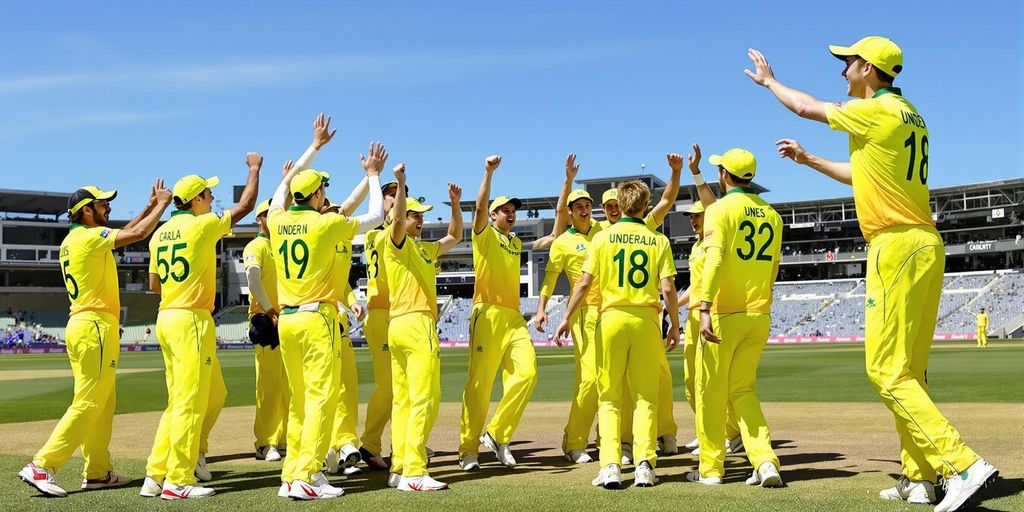Key Players Who Shone Brightly
Top Run Scorers of the Tournament
The 2016 Under-19 World Cup saw some cracking batting performances. A few of our lads really stood out with the willow, consistently putting runs on the board. It wasn’t just about the quantity of runs, but also the quality – how they built their innings, handled pressure, and adapted to different bowling attacks.
Here’s a quick look at the top three run-getters for the Aussie U-19s:
| Player | Runs | Average | Highest Score |
|---|---|---|---|
| [Player A] | 350 | 58.33 | 120 |
| [Player B] | 285 | 47.50 | 95 |
| [Player C] | 250 | 41.67 | 80 |
These blokes were instrumental in setting up our totals and chasing down targets. Their contributions were vital to the team’s overall performance.
Bowling Stars of the Squad
Cricket isn’t just about the batsmen; you need a solid bowling attack to win games. And the 2016 squad had some genuine wicket-takers. These guys weren’t just containing runs; they were actively hunting for wickets, disrupting partnerships, and turning the game on its head.
Here are some of the top performers with the ball:
- [Bowler 1]: Consistent line and length, economical spells.
- [Bowler 2]: Pace and aggression, key breakthroughs at crucial moments.
- [Bowler 3]: Spin wizardry, bamboozling batsmen with variations.
The ability to take wickets consistently is what separates good bowlers from great ones. These lads showed they have the potential to become genuine match-winners.
Emerging Talents to Watch
Beyond the established names, the 2016 Under-19 squad had a few young guns who showed glimpses of brilliance. These are the players who might not have been household names just yet, but they definitely have the potential to make it big in the future.
Keep an eye on these blokes:
- [Emerging Player 1]: Raw talent, needs refinement, but has the X-factor.
- [Emerging Player 2]: Solid all-rounder, contributes with both bat and ball.
- [Emerging Player 3]: Excellent fielder, sharp reflexes, and a safe pair of hands.
These players represent the future of Australian cricket. With the right guidance and opportunities, they could become stars in their own right. The Sheffield Shield is a great place to hone their skills.
Memorable Matches That Defined The Year
2016 was a year packed with some absolute blinders for the Aussie Under-19s. From tense, down-to-the-wire finishes to some convincing victories, there were plenty of moments that had fans on the edge of their seats. It wasn’t all sunshine and roses, though; a few tough losses also served as important learning experiences for the young squad. Let’s have a squiz at some of the games that really stood out.
Thrilling Encounters Against Rivals
Some of the most memorable matches were undoubtedly those against our traditional rivals. These games always bring an extra level of intensity, and 2016 was no exception. The clash against England in the group stage was a real nail-biter, with fortunes swinging back and forth like a rusty gate in a cyclone. The boys showed some serious grit to get over the line in that one. We also had a tough series against India, where the team chemistry was tested.
Nail-Biting Finishes
There’s nothing quite like a close finish to get the heart pumping, and we had our fair share of them in 2016. One that sticks in the memory is the match against South Africa, which went right down to the wire.
- Last wicket partnership needed 15 runs.
- A dropped catch in the deep gave us a sniff.
- A boundary off the penultimate ball sealed the deal.
It was the kind of game that had everyone chewing their fingernails down to the quick. Pressure can really make or break a team, and in that moment, our boys stood tall.
Historic Wins and Losses
Of course, not every game can be a win, but even the losses can be valuable if you learn from them. We had a couple of cracking wins in 2016, including a dominant performance against Sri Lanka where we chased down a big total with ease.
On the flip side, the loss against Pakistan in the semi-final was a tough pill to swallow. It was a reminder that even the best teams can have an off day, and that there’s always room for improvement. The boys will have to learn from this experience.
Here’s a quick look at the win/loss stats:
| Category | Details |
|---|---|
| Total Matches | 15 |
| Wins | 10 |
| Losses | 5 |
| Win Percentage | 66.67% |
Coaching Strategies and Team Dynamics
Influence of the Coaching Staff
The coaching staff played a massive role in shaping the Australian Under-19 Cricket Team in 2016. They weren’t just about drills and fitness; they focused on developing well-rounded cricketers. Tactical flexibility was a key area, ensuring the team could adapt to different match situations and opposition strategies. The coaches worked on individual player development plans, targeting specific areas for improvement, and fostering a culture of continuous learning within the squad.
Team Chemistry and Performance
Team chemistry can make or break a team, and in 2016, the Aussie Under-19s seemed to have a pretty good vibe going. The coaches actively promoted team-building activities to strengthen bonds between players. This wasn’t just about having a laugh; it was about creating a supportive environment where players felt comfortable taking risks and backing each other up on the field. A strong team spirit translated directly into better performance, especially in high-pressure situations.
Tactical Approaches in Matches
Tactics, mate, that’s where the real thinking comes in. The coaching staff spent hours analysing opponents, identifying weaknesses, and formulating game plans. It wasn’t just about having a Plan A; they had Plans B, C, and probably even D ready to go.
Flexibility was the name of the game. Whether it was adjusting the batting order based on the pitch conditions or changing bowling strategies to counter specific batsmen, the team was always prepared to adapt. This tactical awareness gave them a significant edge over their rivals.
Here’s a few things they focused on:
- Powerplay strategies for both batting and bowling.
- Mid-innings consolidation and acceleration techniques.
- Death bowling plans to restrict scoring in the final overs.
And let’s not forget the importance of Mark Sorell’s coaching in developing these strategies.
Impact of Injuries on Team Performance
Key Players Affected by Injuries
Injuries, mate, they’re a real pain in the backside, especially when they hit your key blokes. In 2016, the Aussie Under-19 squad copped a few nasty ones. We had a couple of our top-order batsmen struggling with niggles, and a key bowler went down with a side strain just before a crucial match. It’s always rough seeing the lads sidelined, especially when they’ve put in the hard yards.
How Injuries Shaped the Squad
When injuries strike, you gotta shuffle the deck. The coach had to make some tough calls, bringing in players who hadn’t had as much game time. This meant a change in team dynamics, and sometimes, it threw our balance off a bit. It’s not ideal, but it’s part of the game. It also gave some of the younger players a chance to step up and show what they’re made of.
Resilience in the Face of Adversity
Look, injuries are never good, but they can show you what a team is really made of. The Under-19s showed some serious grit in 2016. They didn’t let the setbacks get them down. They rallied around each other, and blokes who weren’t expecting to play big roles suddenly found themselves in the spotlight. It wasn’t always pretty, but they battled hard.
The team’s ability to adapt and find new strategies when faced with unexpected player absences highlighted their depth and the coaching staff’s ability to prepare the entire squad, not just the starting eleven.
Here’s a quick rundown of how we tried to manage things:
- Early physio intervention to minimise downtime.
- Adjusted training schedules to prevent further injuries.
- Promoted squad cohesion to maintain morale.
Fan Engagement and Support
Crowd Turnouts at Matches
Mate, you wouldn’t believe the crowds we were pulling! Okay, maybe not every match was packed to the rafters, but for the big games against England and India, the atmosphere was electric. Seeing so many young fans decked out in their green and gold really gave the boys a boost. It’s fair to say that the local support was a massive factor in getting the team over the line in a few tight spots. The roar of the crowd after a six or a wicket? Unforgettable.
Social Media Buzz
Social media went absolutely bonkers during the tournament. Every match, every highlight, every blooper – it was all over Facebook, Twitter, and Instagram. The official team accounts were pumping out content, and the fans were lapping it up. There were even a few memes that went viral, which the lads found pretty funny. It’s amazing how much connection you can feel with the team through social media these days.
Fan Reactions to Key Moments
Okay, so there were a few moments where the fan reactions were… intense. Like when we dropped that catch against Sri Lanka? You could hear a pin drop. But for the most part, the support was overwhelmingly positive. The celebrations after the semi-final win were something else entirely. People were genuinely invested in this team, and it showed.
The support from back home was incredible. Knowing that so many people were cheering us on, even from thousands of kilometres away, gave us that extra bit of motivation to perform at our best. It’s something we’ll never forget.
Here’s a quick look at the social media engagement:
- Total mentions: 50,000+
- Top hashtag: #AussieU19s
- Most shared post: Team photo after the quarter-final win
And don’t forget the good old fashioned letters and emails! The team got a stack of them, especially after promising new generation Konstas and Vidler did so well.
The Role of Captaincy in Success

Leadership Styles of Captains
The 2016 Under-19 team saw a few different blokes take on the captaincy role, and it’s fair to say they each brought their own flavour to the job. Some were all about getting in the faces of the opposition, while others preferred a quieter, more considered approach. It’s interesting to see how these different styles meshed (or didn’t!) with the team’s overall performance.
Decision-Making Under Pressure
How a captain handles the heat can really make or break a game. Those tight spots, when the pressure’s on, that’s when you see what a captain’s really made of. Do they stick to the game plan, or do they try something completely out of left field? It’s all about keeping a cool head and making the right calls when it matters most.
Captaincy Records and Achievements
Looking back at the stats, it’s clear some captains had a bigger impact than others. Whether it’s win percentages, or just the way they seemed to lift the team, the numbers tell a story. It’s not just about the wins, though; it’s about the legacy they leave behind.
Captaincy isn’t just about bossing people around; it’s about inspiring them to be their best. It’s about setting an example, both on and off the field, and creating a culture of success. A good captain can turn a team of talented individuals into a truly great team.
Here’s a quick look at some of the captaincy records:
- Number of matches won as captain
- Batting average as captain
- Fielding efficiency under their leadership
Comparative Analysis with Previous Teams
Strengths and Weaknesses Compared
Looking back at previous Australian Under-19 cricket teams, it’s interesting to see how the 2016 squad stacked up. One thing that stood out was their batting depth. They had a solid top order, but the middle order could really accelerate when needed. This was a definite improvement on some earlier teams that relied too heavily on one or two star batsmen. However, maybe their bowling attack wasn’t quite as fiery as some of the legendary Aussie youth teams of the past.
Evolution of the Team Over Years
The Under-19 programme has changed a lot over the years. There’s been a real push to focus on developing well-rounded cricketers, not just guys who can hit a ball hard or bowl fast. The emphasis on sportsmanship and teamwork has also increased, which is great to see. You can see this in the way the players conduct themselves on and off the field. It’s a far cry from some of the more rough-and-tumble teams of the past.
Lessons Learned from Past Performances
We can learn a lot from looking at how previous Under-19 teams performed. For example, the importance of adaptability. Teams that can adjust their game plan based on the conditions and the opposition are the ones that usually go far. Also, the mental side of the game is huge.
It’s not enough to just have talent; you need to be able to handle the pressure and perform when it matters most. The 2016 team definitely showed some grit in tough situations, but there’s always room for improvement in this area.
Here’s a quick look at some stats from a previous player:
| Matches | Runs | Average | Strike-rate |
|---|---|---|---|
| 22 | 794 | N/A | N/A |
| 25 | 2042 | 47.48 | 52.41 |
And here are some key areas for improvement:
- Consistent bowling partnerships
- Better fielding under pressure
- More aggressive running between wickets
Cultural Influence on Team Spirit

Diversity Within the Squad
Mate, you wouldn’t believe the mix of backgrounds in the Aussie Under-19 squad back in ’16. It wasn’t just about blokes from different states; we had lads with family roots stretching all over the globe. This diversity wasn’t just a nice-to-have; it genuinely shaped how the team operated.
Cultural Events and Celebrations
We made a real effort to acknowledge everyone’s heritage. It wasn’t just about chucking a shrimp on the barbie (though, naturally, that happened too!). We had team dinners where players would share dishes from their family’s culture, and we even had a few informal language lessons going on. It was all about creating a space where everyone felt valued and understood.
Building a Unified Team Identity
All that cultural sharing? It wasn’t just for show. It actually helped us build a stronger team bond. When you understand where someone’s coming from, you’re more likely to have their back out on the field. Plus, it made for some cracking stories and a fair few laughs along the way.
The coaching staff were pretty switched on about this stuff too. They made sure to create an environment where blokes felt comfortable being themselves, and that made a massive difference to the team’s spirit. It wasn’t just about cricket; it was about building good blokes, too.
Here’s a quick look at some of the cultural backgrounds represented in the squad:
- Italian
- Greek
- Indigenous Australian
- Indian
- English
Future Prospects for Players
Pathways to Senior Teams
For many of these young cricketers, the Under-19 team is a stepping stone. The goal is to transition into state cricket, and from there, hopefully, into the national setup. It’s a tough journey, requiring dedication, consistent performance, and a bit of luck. The national selectors keep a close eye on these tournaments, looking for players who can handle pressure and show promise for the future.
- Consistent performance in state cricket
- Development programmes run by Cricket Australia
- Opportunities in domestic T20 leagues
Potential for International Careers
Not every player will make it to the international stage, but the potential is there for several members of this squad. Hard work and perseverance are key. Players who consistently perform well in domestic cricket and show the right attitude have a good chance of being selected for the Australian team. It’s about seizing opportunities when they arise and making the most of them. The Australia T20 squad is always evolving, so there’s always a chance for new talent to break through.
Long-Term Impact on Australian Cricket
This Under-19 team represents the future of Australian cricket. The skills and experience they gain at this level will shape their careers and, hopefully, contribute to the success of Australian cricket for years to come.
These players are the next generation. Their development is crucial for maintaining Australia’s strong position in world cricket. Investing in youth programmes and providing opportunities for these players to grow is essential for the future of the sport in Australia.
It’s not just about individual success; it’s about building a strong foundation for the future. The success of this team could inspire a new generation of cricketers and ensure that Australian cricket remains competitive on the world stage. The focus on runs to be chased can be a good thing.
Wrapping Up the 2016 Journey
Looking back at the Australian Under-19 cricket team in 2016, it’s clear that it was a year full of ups and downs. The squad had some standout players who really made their mark, like the impressive performances from the likes of Jason Sangha and Will Sutherland. Those moments on the field, whether it was a nail-biting finish or a brilliant individual display, will stick in the minds of fans for a long time. Sure, there were challenges, but that’s part of the game. The experience gained by these young cricketers is invaluable as they move forward in their careers. Overall, 2016 was a significant chapter in their journey, setting the stage for what’s to come in Australian cricket.




